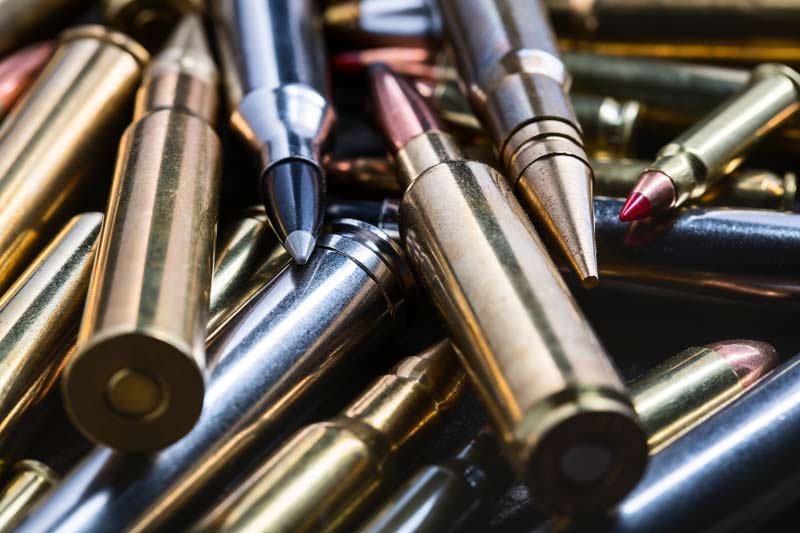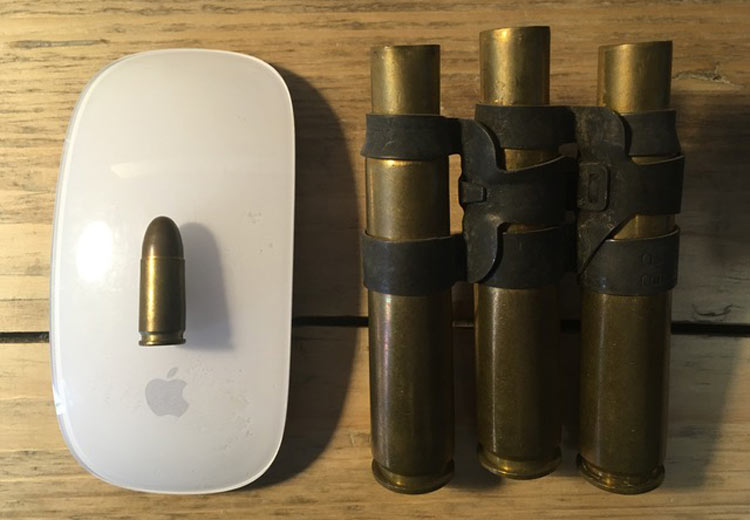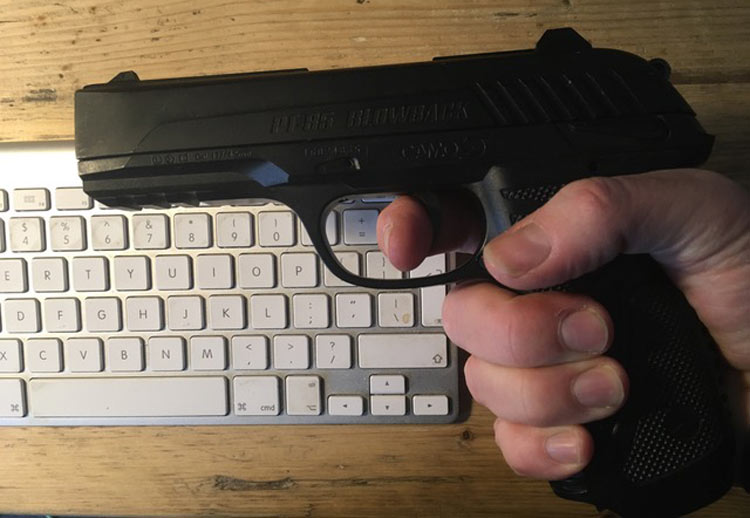
How to make sure your fictional firearms don’t jam
Part two of a two-part series. See part one: The right way to write about guns in novels
Rounds, cartridges, shells or bullets? In this article I’ve been scrupulous about referring to “rounds” when I mean the things you load into your firearm and “bullets” when I mean the things whistling down the barrel.
People do tend to use these terms interchangeably, and for your book or character, that may be fine. May be entirely appropriate, in fact. But if your character is a cop, or a private eye, or a soldier, vigilante, prepper or gun-shop owner, you need to know the basics.
Without going into the real detail (meplat, anyone?*), here are the fundamental terms you need to know.
The bullet is the flying bit that comes out of the muzzle and does all the damage. It’s usually but not always made of lead and it may be completely or partially covered with a copper skin. It sits in a brass case. This case is also known as a cartridge case or shell case/casing.
The case contains the gunpowder or, in contemporary weapons, propellant. Be aware that cordite as a propellant is rarely used nowadays and certainly not in commercially produced ammunition. If you really want to get into it, the correct generic term would be “smokeless propellant.”
The third major component of a cartridge is the primer. This is the little dot on the rear-facing end of the cartridge. It contains a different variety of powder that ignites the propellant.
The whole thing is called a round or shell or cartridge. Military types tend to talk about rounds.

David and Goliath: On the left, a 9mm pistol round with FMJ ball-type load. On the right, three .50 BMG heavy machine gun shell cases (minus bullets).
‘I’ve been hit!’
I don’t want to get too gory here, but we should touch on what happens when someone in your book is actually hit by a bullet. Here are a couple of headlines.
First, gunshot wounds really, really hurt. You don’t just clap your palm over the hole and grit your teeth then carry on doing whatever it was you were doing before you got shot. Imagine being stung by a bee on the tip of your nose. Or somewhere more intimate. While a brick falls on your head from somebody’s roof. Causing you to slip when peeling an apple with your Bowie knife and cut the end of your finger off.
That.
If they’re not in shock, or unconscious, people tend to scream and yell when they get shot. Did I say it hurts? The line I hate most in movies and TV? “It’s just a through-and-through.” As if.
I spent some time on your behalf reading forum posts from survivors of shootings and viewing some distressing images of gunshot wounds. I found a report from a US Army veteran who’d been shot in Afghanistan. The bullet entered his left calf and exited near his knee cap. Yes, it hurt. And he was on crutches for three months. Not up and sprinting after the bad guy seconds later.
Another guy took an eeny-weeny .22 to the chest. A kid’s round ferchrissake! He reported it as feeling like an elephant sitting on his chest. No, wait, like an elephant sitting on a knife in his chest.
There’s also that little distinction between full metal jacket and hollow-point rounds, most commonly known as jacketed hollow-points on account of having a partial copper casing to the lead core.
Many folks believe jacketed hollow-points to be worse than full metal jacket rounds on impact. And it’s true that because they expand on impact, they can make a real mess of your insides. But here’s the thing. So can JHP rounds.
The thing to bear in mind is the kinetic energy that the incoming round transfers to your body. It’s a lot. Even without the flattening effect caused by the pre-cut grooves in a JHP, a bullet is going to really mess up your insides. Depending on the point of impact, it’ll break bones, rip chunks out of you and destroy soft tissue.
The main thing JHPs do is stay inside the victim/target’s body. This is critical for law enforcement professionals who only want to injure/kill the target, not some innocent bystander.
One of the reasons the NYPD eventually approved JHP ammunition for all its officers was the following statistic: between 1995 and 1996, of the 121 people hit by NYPD bullets, 41 were hit by bullets that had already gone through somebody else. Of those 41, 36 were FMJ and 5 were JHP, according to the New York Times.
If your characters are military and firing a long gun, chances are they’ll be using FMJ rounds. This is because these are a) more accurate over longer distances and b) not banned under the Geneva Conventions. If they’re a civilian or a police officer, it’s more likely they’ll be using JHPs.
A final word on gunshot wounds. We’re back to Harry Callaghan again. The second part of that famous quote from the movie is where Harry says, “But being this is a .44 Magnum, the most powerful handgun in the world and would blow your head clean off, you’ve gotta ask yourself one question: Do I feel lucky? Well, do ya, punk?”
Clean off? Really? Yes. It would. It might be cool or appropriate for your character to wield such a devastating weapon, but if they do, and they fire it, and they hit somebody, be prepared for what happens next. Like maybe call a good firm of cleaners. And an interior decorator.
Get some GSR on your hands
Writers love research. And in my own pursuit of accuracy I took myself off to a gun range. Now, being as how I live in England, where we have very strict laws around guns, and handguns are verboten outside of the military and law enforcement, that meant I had to travel.
To Canada. And the fine people at The Range @UrbanTactical 67 miles southwest of Toronto. There, together with my wife and two sons, I tried my hand with a variety of firearms including a Glock 17, a 1911 in .45 and a Smith & Wesson Model 629 chambered for .44 Magnum. (The latter is the Dirty Harry weapon but in all stainless steel.)
Firing the Glock was essentially effortless. Minimal recoil. You could pop away all day with that baby. The .45 upped the ante a bit. A real kick when you squeezed off a round. But the big kahuna burger was the Smitty. To give you an idea of its power and unpredictability in the hands of a novice, the instructor told us, jovially, how they only load three rounds into the cylinder, with empty chambers in between. Why?
Because most people, on pulling the trigger, freak at the recoil and pull the trigger as a reflex action, sending a massive lump of lead into the ceiling.
We’re instructed not to use clichés. So I won’t say it kicked like a mule. But how to describe the sheer physicality of the experience? Well, I guess it was like trying to hold a door shut while someone on the other side tried to batter it down with a sledgehammer. Yes. Something like that.
Nowadays, the .44 Magnum is no longer the most powerful handgun in the world. There are bigger and more badass weapons such as the Smith & Wesson 500 Magnum. I talked to my friend and firearms expert Bill Wilson about guns that hurt the shooter. Here’s his verdict on the 500. “It doesn’t kick as much as it rocks you to your core. I will not shoot one.”
I was also fortunate enough to get a guided tour around the British Army’s main weapons storage facility by its commanding officer, my friend Mike Dempsey. Woo! Like a kid in a candy store. We’re talking every single type of munition the Army uses from rinky-dink .22 rounds through depleted uranium projectiles (unnervingly heavy for their size) up to Javelin anti-tank missiles.
Mike let me handle (unloaded) a Browning .50 caliber M2 heavy machine gun, which starred in my first Gabriel Wolfe novel, Trigger Point, as well as its Russian equivalent, the Dushka; a Kalashnikov AK-47, and an SA80 British Army personal weapon.
If you can’t get your hands on real weapons – or you simply prefer not to – there are a wealth of books, websites and, best of all, YouTube videos where you can get pretty close to a first-person experience with virtually any type of firearm on the planet. Befriending a gun owner/military veteran is also a great idea.

It’s an air pistol, but it’s heavy, with a working slide, and it gets the author in the mood for writing firearms scenes.
Putting a gun in your character’s hand
Lethality is often falsely associated with power and caliber. There’s a temptation for writers to go for the “bigger is better” route, where every character is toting some oversized gun bristling with large-capacity magazines, laser or telescopic sights and grenade launchers.
In reality, shot placement is a far greater determinant of lethality. A .22 FMJ round through the eye or roof of the mouth will kill. A .50 caliber hollow-point fired from the aforesaid S&W 500 Magnum will probably miss the target altogether on account of the monstrous recoil. Hit a hand, though, and it’ll probably take the victim’s arm off altogether.
In choosing a firearm to give your fictional character, you should follow the same basic reasoning as if you were equipping yourself. What’s it going to be used for? How is it going to be carried? Can I actually get hold of one? What sort of ammunition do I need or want?
A brash young Russian gangster might look good with a chrome-plated Model 629 with an 8 3/8-inch barrel. But these are ruinously painful to shoot and are really designed more as backup weapons for big game hunters and people who might encounter apex predators like polar bears. You certainly wouldn’t put one into the purse of a soccer mom unless you were going for black humor.
A farmer won’t be ridding his barn of vermin with a Barrett Light Fifty sniper rifle. Nor will a Special Forces operative be going into battle with a break-action shotgun. If your character carries a gun because of their job, then you don’t get a lot of choice. Police forces, security agencies and military organizations make standardized choices of firearms. You can look these up on the Web easily.
Hold your fire!
Guns are like any other piece of equipment that might appear in your novel. There’s a right and a wrong way to describe them, their use and their effects. If guns aren’t central to your story, my advice would be to default to general terms. Gun is fine. So is bullet.
If a householder is confronted by a burglar and her husband yells out, “Look out, honey, he’s got a gun!,” 99.9% of your readers will picture some kind of handgun, not a sniper rifle or heavy machine gun.
But if guns play a more central role, perhaps because a character is herself knowledgeable about firearms, then when you’re writing from her POV, you need to be on point. If for no other reason, it drives those who actually do know about guns crazy.
Increasingly, though, lots of people know a bit about guns. Make a boo boo and there’s the risk you drop them out of the story as they wonder, well, is he talking about a rifle here? Because I thought rifles fired bullets not buckshot. It’s the fictional equivalent of the theatrical term “breaking the fourth wall” where the reader/viewer becomes aware they are consuming a work of art, not experiencing the world it’s depicting.
Further reading
There are lots of books on guns available. I own these three:
- The Writer’s Guide to Weapons
- Gun Digest Illustrated Guide to Modern Firearms
- Military Small Arms of the 20th Century
Note: I’d like to thank William Wilson, my go-to guy for all matters firearms, for reading this article in draft and making a couple of valuable suggestions about suppressors and large-caliber weapons. Thanks, Bill.
* Meplat. n. the tip of a bullet.







You got the basics of firearms ammunition about right. But, for the record, very few guns come from a factory chrome plated. For a couple of centuries, the plating of choice has been nickle. And, that .44 Magnum 629 you describe as “chrome” would actually, if it gleamed and glistened just been highly polished. Stainless by itself is rather dull, a matte finish more of less. But they can be made to shine with time spent with a polishing wheel and a gentle hand. Carbon steel guns were traditionally nickle plated to prevent corrosion. The cosmetics was secondary. Today, it… Read more »